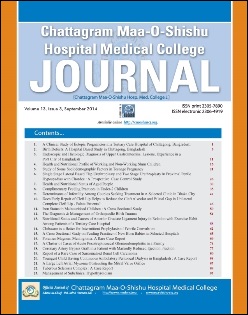Birth Defects: A Hospital Based Study in Chittagong, Bangladesh
DOI:
https://doi.org/10.3329/cmoshmcj.v13i3.20994Keywords:
Birth defect, Sex, Systemic distribution, Operations, OutcomeAbstract
Introduction: Birth defects are one of the most common causes of disability in developed and developing countries. Birth defects are structural or functional anomalies, including metabolic disorders, which are present at the time of birth. Although the worldwide incidence of birth defects is estimated at 3-7%, the rate varies widely between countries. In this paper, we categorized the birth defects most commonly seen in Bangladesh and their outcome. We hope to use this information to guide the strategies used to manage these problems.
Materials and Methods: This hospital based, descriptive study was done in the Department of Pediatric Surgery in Chittagong Medical College and Hospital from January 2008 to December 2012. Records of all patients with birth defects in our hospital and departmental database were reviewed. Types of birth defects, age, sex, surgery performed and outcome were analyzed in patients admitted during this period. Data were analyzed by SPSS 17. Statistical analysis was performed by the chi-square test and mean and percentage values were calculated. P<0.05 was considered to be statistically significant.
Results: During this five year period, there were 5661 patients of birth defects admitted in this department. Of these, 5156 had a single congenital anomaly and 505 had multiple congenital anomalies. The male to female ratio was 2.1: 1. Birth defects comprised 44.61% of all Pediatric surgical admissions and 0.90% of total hospital admissions. The gastrointestinal system was the most common organ system involved, followed by the genitourinary system. Inguinal hernias were the most common gastrointestinal abnormality and hypospadias were the most common genitourinary case. A total of 3921 operations were performed for birth defects, representing 69.26% of total admission for birth defects. Most operations were done for gastrointestinal and genito-urinary defects. Inguinal herniotomy was the most commonly performed operation followed by laparotomy for various indications. There were 225 deaths for birth defects. While this is only 3.97% of all admissions for birth defects, this represents 51.49% of all (pediatric) deaths during the study period. The most common cause of death was anorectal malformations followed by gastroschisis.
Conclusion: The study helps assess the burden of birth defects in the Bangladeshi society. There is a need for more extensive, nationwide screening studies to determine the birth prevalence, types and distribution of birth defects in Bangladesh.
Downloads
512
474
Downloads
Published
How to Cite
Issue
Section
License
Authors of articles published in CMOSHMC Journal retain the copyright of their articles and are free to reproduce and disseminate their work.
A Copyright and License Agreement -signed and dated by the corresponding author on behalf of all authors -must be submitted with each manuscript submission.

